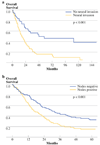Predictors of survival in periampullary cancers following pancreaticoduodenectomy
- PMID: 20108122
- PMCID: PMC2861840
- DOI: 10.1245/s10434-009-0883-9
Predictors of survival in periampullary cancers following pancreaticoduodenectomy
Abstract
Background: Cancers of the ampulla of Vater, distal common bile duct, and pancreas are known to have dismal prognosis. It is often reported that ampullary cancers are less aggressive relative to the other periampullary carcinomas. We sought to evaluate predictors of survival for periampullary cancers following pancreaticoduodenectomy to identify biologic behavior.
Methods: We reviewed the records of all patients who underwent pancreaticoduodenectomy for periampullary carcinoma between 1992 and 2007 at the Ohio State University Medical Center. Demographics, treatment, and outcome/survival data were analyzed. Kaplan-Meier survival curves were created and compared by log-rank analysis. Multivariate analysis was undertaken using Cox proportional-hazards method.
Results: 346 consecutive periampullary malignancies (249 pancreatic cancers, 79 ampullary carcinomas, 18 extrahepatic cholangiocarcinomas) treated by pancreaticoduodenectomy were identified. Pancreatic cancer histology correlated with the shortest median survival (17.1 months), followed by cholangiocarcinoma (17.9 months) and ampullary carcinoma (44.3 months) (P < 0.001). Potential predictors of decreased survival on univariate analysis included site of origin, preoperative jaundice, microscopic positive margin, nodal metastasis, lymphovascular invasion, neural invasion, and poor differentiation. Only nodal metastasis (median 16.2 versus 29.9 months, P < 0.001) and neural invasion (median 17.7 versus 47.9 months, P < 0.00001) significantly predicted outcome on multivariate analysis.
Conclusions: Although ampullary cancers have the best prognosis overall, when controlled for tumor stage, only presence of neural invasion and nodal metastasis predict poor survival following pancreaticoduodenectomy. Biological behavior remains the most important prognostic indicator in periampullary cancers amenable to resection, regardless of site of origin.
Figures
References
-
- Sarmiento JM, Nagomey DM, Sarr MG, Farnell MB. Periampullary cancers: are there differences? Surg Clin North Am. 2001;81(3):543–555. - PubMed
-
- Cameron JL, Crist DW, Sitzmann JV, et al. Factors influencing survival after pancreaticoduodenectomy for pancreatic cancer. Am J Surg. 1991;161(1):120–124. discussion 124–5. - PubMed
-
- Androulakis J, Colborn GL, Skandalakis PN, et al. Embryologic and anatomic basis of duodenal surgery. Surg Clin North Am. 2000;80(1):171–199. - PubMed
-
- Bassi C, Dervenis C, Butturini G, et al. Postoperative pancreatic fistula: an international study group (ISGPF) definition. Surgery. 2005;138(1):8–13. - PubMed
Publication types
MeSH terms
Grants and funding
LinkOut - more resources
Full Text Sources
Medical



